HTC Thunderbolt Review: The First Verizon 4G LTE Smartphone
by Brian Klug on April 27, 2011 12:12 AM EST- Posted in
- Smartphones
- HTC
- Verizon
- LTE
- 4G
- Android
- HTC Thunderbolt
- Mobile
- MDM9600
- MSM8655
So I have a confession to make - I’m late on this one. Way late. I managed to catch strep throat, came down with a high fever, then a sinus infection, and as a result missed my goal of having everything Verizon 4G LTE - including the HTC Thunderbolt - wrapped up and published a few weekends ago. One thing led to the other, and I promised a number of readers both in emails and on Twitter that it would be done a long time before it ended up coming to fruition. I think I’m going to add a week to all time estimations from now on, just to be safe. Apologies if I made you refresh obsessively a few times there.
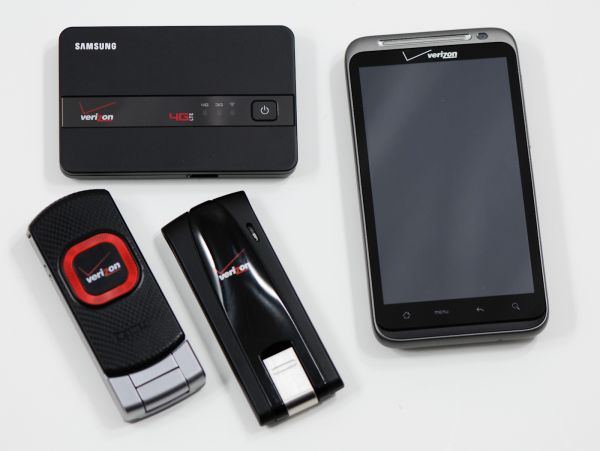
Clockwise from top left: Samsung SCH-LC11, HTC Thunderbolt, Verizon USB551L, Pantech UML290
That said, it isn’t entirely a loss. Over the past month, I somehow have found myself getting slowly buried in literally every single Verizon 4G LTE device (with the exception of the LG VL600 data card) and that’s a good position to be in. The story of our LTE testing started actually before MWC with the Pantech UML290, and since then each time a new device has shown up, I’ve hopped in my car, driven two hours to Phoenix (the nearest LTE market) and spent a sleepless 48 hours testing battery life, speeds, and stability. It’s been a lot of testing, driving, and collecting data. I’ve recorded 542 speed test runs on 4G LTE as a result, and many more on EVDO for comparison. There’s a ton of stuff to go over, so to keep things manageable, I’ve split the review down the middle. This half is HTC Thunderbolt, the other is everything about Verizon 4G LTE from a cellular perspective including two data cards and a WiFi hotspot.
Without any more rambling, let’s get into this review of the first LTE-enabled smartphone on Verizon.
The first thing to say about the HTC Thunderbolt is that it’s gigantic. It’s big simply by virtue of having two transceivers inside, and four antennas. The fact that it’s huge isn’t a bad thing, rather it seems like a smartphone that unblinkingly stares back at legions of notably more superficial smartphones all battling over who is the thinnest (seriously, during CES and MWC several device categories changed thinness crowns in the span of just a few days). It’s almost as if the HTC designers laughed at the trend and boldly designed something different.
I like to think that each section on the site has some insane product that defies reality by being positively huge or defying physics in some manner. Ryan over in GPUs gets to play with his insane AMD 6990 cards and tri-SLI GTX 580s all day. Anand is buried in a house full of 240+ GB SSDs, Jarred and the notebook team does much the same with piles of notebooks, Ganesh with HTPCs, Johan with servers, and so forth. I like to think that the HTC Thunderbolt is in some way analogous to the most insane product in any of those categories, like the 6990 of smartphones, for reasons I’m going to go over in a moment. It’s an exciting smartphone purely because it’s a notable first.
So how is the HTC Thunderbolt? The story of my impressions of this device go all the way back to a Qualcomm meeting at CES when I had hands on with a working version of the phone that had everything but cellular connectivity. Back then, I think the only comment I could mutter at a crowded table surrounded by Qualcomm employees, Vivek, and Anand was - wow, this thing is huge.
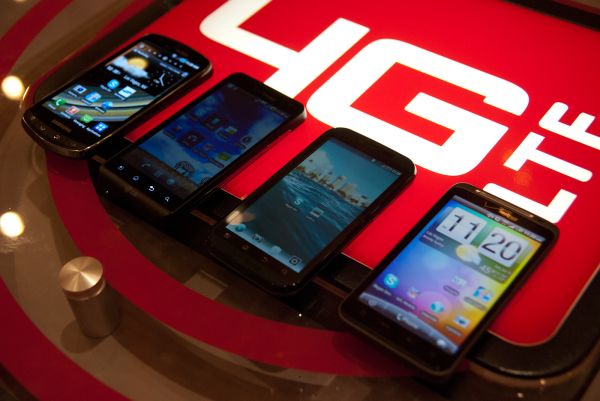
Verizon's 4G LTE Phone Lineup (Left to Right): Samsung Droid Charge, LG Revolution, Motorola Droid Bionic, HTC Thunderbolt
On the last day of CES 2011 I got what would be my last couple of minutes with the Thunderbolt, this time with working cellular connectivity and alongside a crowded lineup of other 4G LTE smartphones launching this year. No speedtests were allowed, just general web browsing. Even at that point, the Thunderbolt was talked about with hushed excitement - this device is furthest along in Verizon’s testing, the rep almost whispered to me. It’ll undoubtedly be the first, if the rest of testing continues as planned. It seemed that everyone knew that the Thunderbolt would be first, and that made it special.
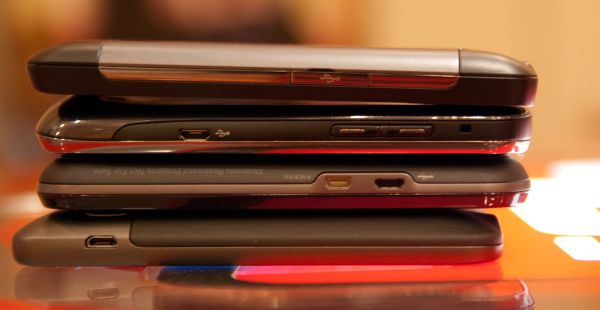
Verizon's 4G LTE Phone Lineup (Top to Bottom): LG Revolution, Samsung Droid Charge, Motorola Droid Bionic, HTC Thunderbolt
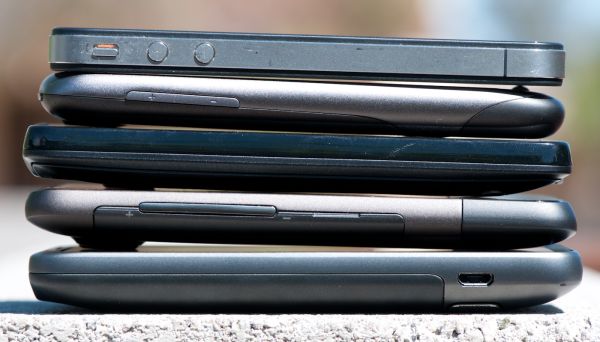
Top to Bottom: iPhone 4, Nexus One, HTC EVO, HTC Inspire, HTC Thunderbolt
The handset itself has a dominant full-hand feel, with good ergonomics. Thickness is where the Thunderbolt is really an outlier, at 13.2 mm, it’s considerably thicker than most of what else is launching lately. In the mass department as well, the Thunderbolt is specced at 173 grams with battery, though I measured 183.3 grams on my balance. As an aside, verifying size and mass is going to be another thing we’re doing going forward, especially after some notable specification confusion from back when I tackled the Fascinate.
Whether the Thunderbolt is simply too chunky depends on your hands and pockets, but there’s no denying that it’s large. Toss in the official double capacity battery which adds a square protrusion to the back, and it’s even larger. Again, simply by virtue of having a 4.3 inch screen, two cellular basebands and being stuffed full of antennas, the phone is going to be larger than average.


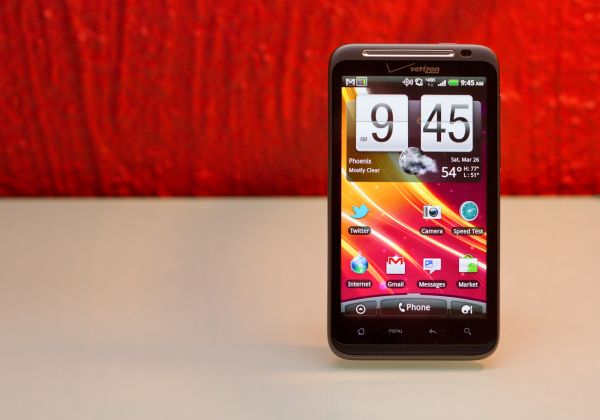
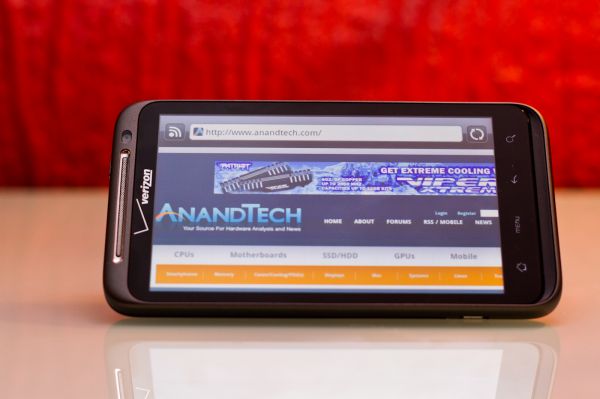














71 Comments
View All Comments
Omid.M - Thursday, April 28, 2011 - link
A friend "in the know" (yeah, yeah) said HTC accidentally shipped it with S-ON for that portion of the internal storage, and that HTC had (has?) issued an OTA that will allow the full 8GB to be useable. Not sure if it's been pushed, as I don't have the Thunderbolt.Brian,
1) How quickly did GPS lock?
I feel like some of these issues that users experience with other phones---e.g. GPS lock on SGS phones---should be considered for reviews of future phones. I know it can be a hassle, but it should highlight that some issues are manufacturer specific. Hopefully, it lights a fire under mfrs. to correct these problems, if they see that other phones don't suffer from the same.
2) Also, maybe I missed it, but has AnandTech established a Light-Moderate-Heavy usage pattern for phones to test battery life?
i.e., Moderate = 45 min of Bluetooth, 20 min GPS navigation, 10 phone calls, 50 sms, 20 still pictures, etc ?
I saw you set display brightness to 50% and loaded web pages, but I'm talking about how a user would normally use the phone: calls, sms, pictures, BT, GPS...etc.
I am positive you guys have done it before.
Really amazing review. Have been spreading the word, hoping more people flock to AnandTech. You guys deserve the recognition!
@moids
Brian Klug - Thursday, April 28, 2011 - link
Moids,I haven't gotten any OTA updates, but that's entirely possible. Sometimes these review units get updates on a different schedule, so I have no idea. I should check whether it's S-ON or S-OFF.
I constantly forget to post about our GPS testing, possibly because I take it for granted these days that devices do it right. It's something I do test however with a bunch of phones at the same time and compare SNR for all the visible satellites using GPS-Test.
GPS locks fast, but not extremely fast. I took multiple road trips to Phoenix with the Thunderbolt doing navigation guidance. I'd say that 15 seconds with complete sky LOS is enough to get a lock. In location services it does have checkboxes for Verizon's location services and google's. I neglected to take screenshots but SNR is very good on the TB, no GPS problems here.
So the battery life test situation is continuing to evolve. We're working on and will have a system trace setup (exactly what you mention, GPS, using the phone, SMS, browsing) eventually. It's still in progress, of course it'd only work for Android comparisons at present.
Thanks for the good word as always ;)
-Brian
Omid.M - Thursday, April 28, 2011 - link
Feature requests:1) permalinking
2) Signature (with char. limit, like 40 chars, for Twitter ID,etc.)
3) Comment reply notification -- this one is HUGE. It's impossible for me to find replies to my comments, given then I can reply to an old comment (so my reply is "newer") but still buried in a sea of comments from older dates. Make sense?
4) Add Tapatalk compatibility to the AT forums. The mods said they're just waiting on Anand to approve, and I've given examples of other forums built on the same system (phpBB, etc) with equal or more users, to show that those forums are working fine and won't buckle under high traffic. Just have to register the forums (free) with Tapatalk so we can post using the Android/iOS app.
Oh, and a Wordpress style mobile version of these articles would be sweet, especially for commenting.
Come on, AT! The best tech site on the net should have these features! :D
Great work as always. Hope you nail those papers, Brian.
Omid.M - Thursday, April 28, 2011 - link
Awesome. Thanks for the reply!The OTA is coming if it hasn't already. I'll check with my source, but he said HTC definitely wanted to make the full 8 GB usable, so it was definitely a minor oversight on their part which they intend to correct.
I don't know why more manufacturers haven't built antennas into the cover. It definitely seems the way to go.
FYI,
Regarding the sig, if you could make it so the badge (to the left) has another bar below the handle where you can put, say, a Twitter ID...well, that'd be slick...hint hint.
That way, since it can only take something like a Twitter ID, you won't have to worry about junk URLs clogging up the comments section. Plus, people can retweet or tweet at individual comments.
Expect more RTs of this article shortly :)
whthawk - Friday, April 29, 2011 - link
Fascinating and easy read. Thanks!FITCamaro - Sunday, May 1, 2011 - link
I love all the people who are like "its thick and heavy....waaaa..." Man up people. Some of us like to have a phone that has some meat to it so we don't feel like we're going to break it. Nor is 5 ounces instead of 4 going to make any difference. For me even the Thunderbolt barely is noticeable when I'm holding it.floyd1 - Wednesday, May 4, 2011 - link
he folks who can tell me how can i order this htc thunderbolt???? and what is the price??? hope some one can help me my regards floyd from hollandname99 - Saturday, May 7, 2011 - link
"The Thunderbolt has noticeably less attenuation when held in a 4G LTE scenario, no doubt thanks in part to the fact that it's fully leveraging MIMO "This statement makes no sense.
(a) To know what is going on requires knowing what is being reported by that signal strength number. THE big issue with mobile radio is the VARIANCE in signal strength. This variance occurs on a timescale of 10s of ms, and a spatial scale of cm/
So when that dB number is reported, what EXACTLY is being reported? The maximum value over the past n seconds? The minimum value? A time average of the power, converted into dB? A time average of the dB rating. (Since the mapping from power to dB is non-linear, these two types of averages are VERY different),
(b) MIMO is NOT a technology to deal with a weak radio signal, in fact the exact opposite.
Given two antennas, you can use them in two DIFFERENT ways.
(i) You can use the two antennas via receive diversity, which means they each pick up an independent version of what is essentially the same signal. This is useful when the amount of signal variance means that one of the signals is frequently too weak to be useful, but usually not both, so at least one of the signals is strong enough to be useful.
ST codes like Alamouti are a fancy version of this idea.
Note --- this is useful for situation where the combination of the mean signal strength AND the variance means that the signal is sometimes too weak. It does not help if the mean strength is too low to be useful; it is a coping mechanism for a high variance.
(ii) MIMO is different. MIMO says we will use the two antennas to decode what are essentially two independent streams of data, and double our throughput. For this to work, we require that the lowest signal strength received (even in the presence of variance) not be too low. Thus this is a technology to take advantage of either a high mean signal strength, or an unusually low variance in the signal strength.
You can use your antennas to give you either diversity (more consistent reception) or MIMO (higher throughput, under good conditions), but not both.
NEITHER diversity nor MIMO can deal with a signal that is too weak. There IS multi-antenna technology that can do this (beam shaping) but I don't know if any carrier or cell-phones use this.
In other words, if this phone shows lower attenuation when being held
(a) who knows WTF that actually means, since we have no idea what is actually being measured
(b) it likely has more to do with the details of the placement and geometry of the antenna than with antenna diversity
(c) it certainly has nothing to do with the specific technology of MIMO
name99 - Saturday, May 7, 2011 - link
Having made the complaint above, congrats to Brian for taking my earlier complaints about these reviews to heart and trying to get a more comprehensive picture of the capabilities of these phones beyond mere headline numbers!Certainly, for example, the histograms are very helpful.
EvoGuy - Monday, May 16, 2011 - link
Droid Charge does not have an MDM9600 or any other Qualcomm IC.Of the four LTE smartphones coming to Verizon, only HTC has a Qualcomm LTE IC. CDMA is handled by VIA in the Charge, Q has the other three.
Also, EV-DO stands for EVolution-Data Only. "Data Optimized" is a backronym to try and cover up the fact that EV-DO cannot support voice. There was a standard called EV-DV (EVolution - Data & Voice), but it was killed by the giant IC company.